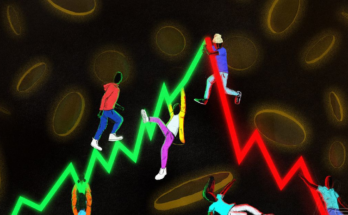At a Mexican restaurant in North London a few weeks ago, a handful of small-time but remarkably discerning retail cryptocurrency investors predicted that terra and luna would crash. Several of them were scoffing at terra, or UST, a stablecoin whose price equivalence to the dollar is underpinned by algorithms and game theory rather than cash or collateral, and at the notion that it would maintain its peg in the long run.
The “Ponzinomics” of the project, they informed me, were just too risky. Only one of the investors seemed optimistic, out of nihilism rather than trust in terra’s solidity. He said that at some point UST’s price would grow well above one dollar per unit, and the coin’s promoters would decide to just keep it there and rebrand the stablecoin as an “inflation-resistant cryptocurrency dollar.” Another shrugged but conceded that all bets were off. “So far,” he said, “this story has always followed the most humorous timeline.”
You can bet a lot of people do not feel like laughing today. UST has lost its peg to the dollar (at the time of writing, you can buy it on cryptocurrency exchanges for $0.58), and its sister asset luna has plummeted from $82 last week to $0.02. A big chunk of the investment of around $60 billion in these cryptocurrencies was pulverized overnight, and more of it will follow as people scramble to get rid of their diminished coins.
Meanwhile this week, the wider crypto market is in turmoil as bitcoin fell to $27,000 after bleeding 8 percent of its value in 24 hours, and many other cryptocurrencies are trailing its descent. Tether, the world’s largest stablecoin, dropped under $1 on Thursday.
With terra, we are witnessing the crumbling of a project predicated on the notion that you can create money—and assign it a specific value—if people are willing to go along with the pretense that money has the value that crypto companies assign it, akin to role-playing in a video game.
A small subsection of hardline crypto believers would retort that in the age of post-gold-standard fiat money, most currencies are indeed just a collective delusion. But the fact that there is no government, central bank, economy, or actual usage underpinning terra matters. As Frank Muci, a policy fellow at the London School of Economics’ Growth Lab Research Collaboration, puts it, “It is similar to a bank run, except it’s a run on nothing.”
UST was marketed to the public as a stablecoin, a type of cryptocurrency whose value supposedly remains steady over time, creating a convenient edge against the wild price fluctuations of other cryptocurrencies like bitcoin or ether. With most stablecoins, that stability is guaranteed by currency reserves—whoever creates a stablecoin pegged against the dollar should theoretically keep an equivalent amount of dollars in a vault somewhere—or other collateral, including crypto. Except UST is an “algorithmic stablecoin” and has none of that. It is fully shielded from the real world, and takes pride in it.
On Terra’s own blockchain, UST has a symbiotic relationship with its satellite asset luna, which can be used to earn cryptocurrency rewards. It was always possible to exchange UST for luna and vice versa, and the blockchain’s own code always made sure that terra traded at a dollar a unit, while luna’s varying price was determined by algorithms keeping an eye on the market.



